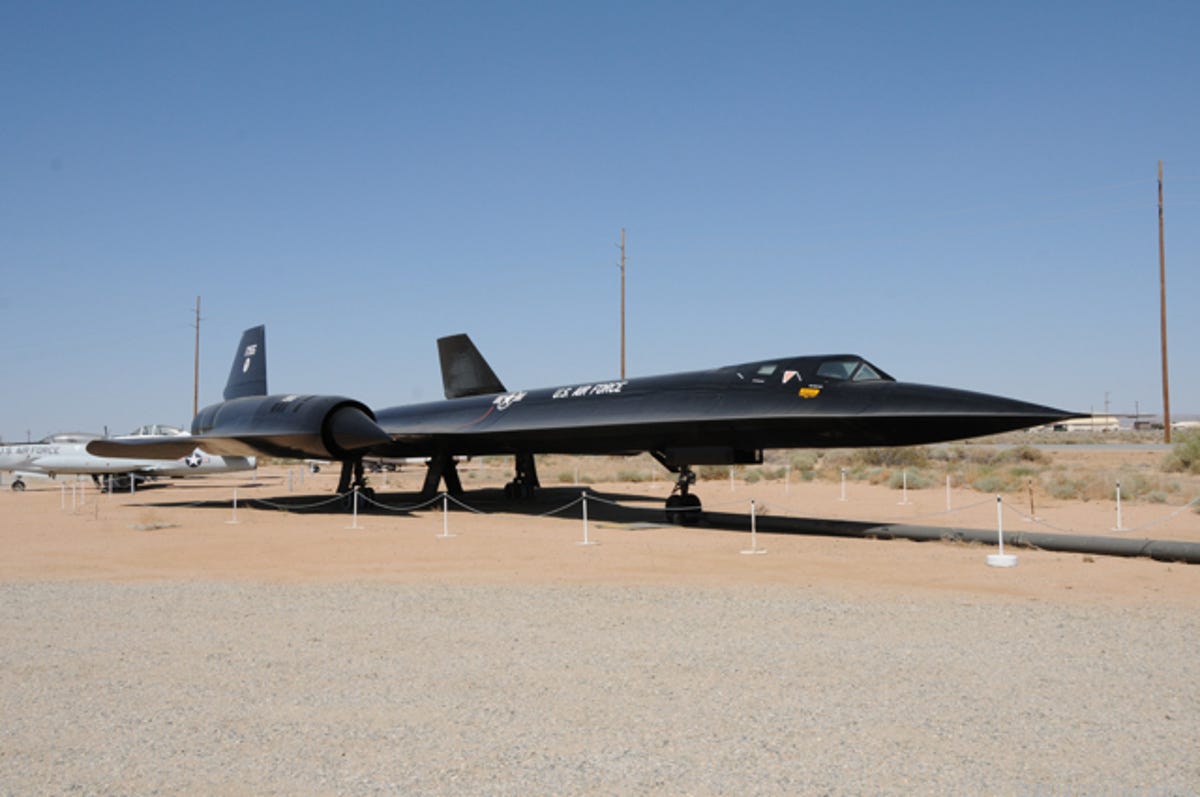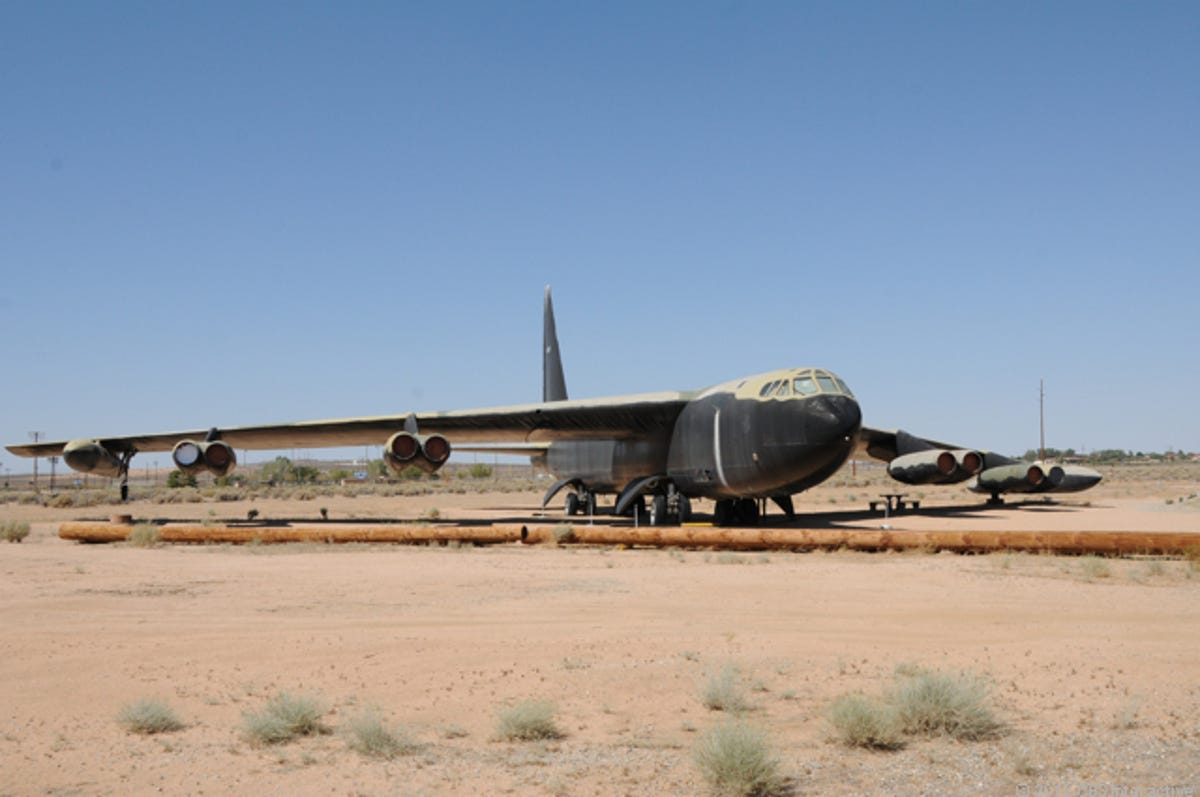The Mojave, the beating heart of the aviation world (pictures)
The vast desert northeast of Los Angeles is filled with military and civilian aviation facilities -- and some of the most exciting aircraft in history fly, and have flown, there.

SR-71 Blackbird
MOJAVE DESERT, Calif.--Although aviation history started in North Carolina and is carried out -- often at a high level -- throughout the world, there's likely no place on Earth more devoted to -- or accomplished at -- the craft than the communities and facilities, both civilian and military, of this huge, arid, mostly flat, often sweltering desert north and east of Los Angeles.
Whether it's Edwards Air Force Base, NASA's Dryden Flight Research Center, the Mojave Air and Space Port, the Southern California Logistics Airport, or elsewhere in the area, the desert almost seems to breathe aviation. This summer on Road Trip 2012, and during previous forays to the area, CNET reporter Daniel Terdiman took in some of the best the area has offered the world -- and it is a world-class list.
This is the Lockheed SR-71, a Mach 3 reconnaissance aircraft, located at the Air Force Test Flight Center Museum, at Edwards Air Force Base. According to the Smithsonian's National Air and Space Museum, "No reconnaissance aircraft in history has operated in more hostile airspace or with such complete impunity than the SR-71 Blackbird. It is the fastest aircraft propelled by air-breathing engines. The Blackbird's performance and operational achievements placed it at the pinnacle of aviation technology developments during the Cold War. The airplane was conceived when tensions with communist Eastern Europe reached levels approaching a full-blown crisis in the mid-1950s. U.S. military commanders desperately needed accurate assessments of Soviet worldwide military deployments, particularly near the Iron Curtain," and the existing U-2 was too slow to do the job.

B-52D Stratofortress
This is a B-52 Stratofortress at the Air Force Test Flight Center Museum, at Edwards Air Force Base. According to the museum, the first B-52 first took flight in 1952. Eventually, nearly 750 were build. "Records set by B-52s include the world's first nonstop round-the-world flight by a jet aircraft and the first hydrogen bomb drop. B-52s began flying combat missions in Southeast Asia...(in) 1965." Eventually, B-52s flew 126,615 combat sorties, during which 17 were shot down.
NASA X-48C
This is an X-48C, a prototype of a hybrid wing body airplane currently located at NASA's Dryden Flight Research Center at Edwards Air Force Base. The goal of a plane like this -- which is an 8.5 percent scale version of an eventual full-sized plane -- is to show the the genre of plane has potential. NASA and its corporate partners, Boeing, and Cranfield Aerospace, have already conducted 92 test flights with the X-48C's predecessor, the X-48B.
The team has yet to fly the X-48C, and the expect it may be 10 years or more before the full-sized version flies.
Hybrid wing body airplanes are hoped to offer a wide range of utility, from being bombers, tankers, cargo transporters, command and control planes, or commercial airliners. Some think that since the design can't support windows, paying passengers won't fly on them. But seem think the solution is to build in virtual windows.
WhiteKnightTwo and SpaceShipTwo
During September 2011 festivities to mark the opening of production facilities at The Spaceship Company at the Mojave Air and Space Port -- which is where new models of Virgin Galactic's SpaceShipTwo and WhiteKnightTwo will be built -- the original SpaceShipTwo and WhiteKnightTwo are displayed before an enthusiastic crowd. New Virgin Galactic craft will be used to take tourists willing to pay $250,000 into space.
WhiteKnightOne
The original WhiteKnight, which carried SpaceShipOne high into the sky, appeared for the first time alongside WhiteKnightTwo and SpaceShipTwo last September at the event at The Spaceship Company, in Mojave, Calif.
SOFIA
This is SOFIA -- the Stratospheric Observatory for Infrared Astronomy -- which calls Dryden's Palmdale, Calif., facility, home. It is a Boeing 747-SP that was flown by Pan Am and that more recently has been custom retrofitted with a purpose-built door and a large telescope used for observations into the deep night sky.
According to SOFIA's chief science adviser, Eric Becklin, the plane and its telescope are used for, among other things, studying dust out in the stars. "Dust forms planets and us," he said. "We are studying the dust we come from."
X-1E
This is NASA's X-1E, located at the Dryden Flight Research Center. It is part of a series of aircraft -- including the X-1 used by Chuck Yeager to break the sound barrier for first time ever -- that were early leaders in the supersonic flight race.
NASA says that, "The X-1E, the last of the X-1 aircraft series, was used to obtain in-flight data at twice the speed of sound, with particular emphasis placed on investigating the improvements achieved with the high-speed wing. The airplane was the first aircraft to fly supersonically with a 4 percent wing, and thus the first to prove the high-mach capability and adequate stability using a thin airfoil section.
"The X-1E made 26 flights and a captive flight with two NACA High-Speed Flight Station test pilots. It flew to a Mach of 2.24 and an altitude of 73,458 feet. Like its predecessors is was air launched from a Boeing B-29."
F-16 taxiing
This is an F-16, taxiing on the runway at Edwards Air Force Base.
Super Sabre
This is a YF-100A, known as a Super Sabre. It was the Air Force's "first operational aircraft capable of flying faster than the speed of sound (760 mph) in level flight," according to a plaque at the Air Force Test Flight Center Museum. The model took flight in 1953, and it set a number of world records at Edwards Air Force Base. Those include the low altitude speed record of 755 miles an hour, and the high-altitude world speed record of 822.135 miles an hour.
F-104 Starfighter
This is an Air Force F-104, part of the Air Force Test Flight Center Museum, at Edwards Air Force Base. The model is probably best known for another of Chuck Yeager's famous flights, one in which he set the world altitude record. He made it to 103,395 feet before losing control of the plane, which plummeted to the ground. Yeager parachuted to safety, an event chronicled in "The Right Stuff."
The F-104A "Starfighter" "was the first aircraft to hold simultaneous official world records for speed, altitude, and time-to-climb, most of which were established at Edwards AFB," reads a plaque at Edwards.
F-105D
This is the F-105D "Thunderchief," found at the Air Force Flight Test Center Museum, at Edwards Air Force Base. The plane "completed its maiden flight at Edwards (in) 1955," a plaque at the museum reads, "easily exceeding Mach One....It first flew in June 1959. A total of 833 Thunderchiefs of all types were built, including 610 F-105Ds. All models of the F-105 were flight tested at Edwards.
"During the Vietnam War, the F-105D flew 75 percent of all air strikes against North Vietnam (in the) first four years."
F-106B Delta Dart
The F-106B, known as the "Delta Dart," seen here at the Air Force Test Flight Center Museum, first flew in late 1956. In 1959, one of the planes was used to set a world speed record of 1,525.695 miles an hour at Edwards Air Force Base.
Phantom II
Seen at the Air Force Flight Test Center Museum, this is an NF-4C Phantom II. The model was first flown in 1958, and was designed as a U.S. Navy fleet defense interceptor. Later, the Air Force tested it at Edwards as a possible fighter-bomber. The plane could carry twice the bomb load of a World War II-era B-17.
"Phantoms have also served with the U.S. Marine Corps and many foreign nations such as Great Britain, Germany, Japan, and Israel," reads a plaque at the museum. More than 5,000 were built.
747s and 767s
One of the uses of the Mojave Air and Space Port is as an airplane "boneyard." Here, amidst a sea of retired, or at least benched, commercial planes, we see a group of Boeing 747s and a group of Boeing 767s.
Many 747s
Many 747s are seen in the boneyard at the Mojave Air and Space Port in Mojave, Calif.
Many planes at Mojave
Dozens of longterm parked airliners are seen at the Mojave Air and Space Port.
DC-8s
A group of Douglas DC-8s are seen parked in the desert at the Mojave Air and Space Port.
Mojave airport
The control tower -- and restaurant -- of the Mojave Air and Space Port, in Mojave, Calif. The facility is home to Scaled Composites, and The Spaceship Company, the companies behind the production of Virgin Galactic's SpaceShipTwo.
Atlas 747s
Two Atlas Air 747s are parked in the Mojave desert.
Roton ATV
According to NASA contractor Bruce Damer, "The Roton Atmospheric Test Vehicle...is a test vehicle designed to fly on its rotor propeller up to about 6,000 feet elevation, and the model is designed for orbital flight." It is located at the Mojave Air and Space Port.
MB-326 fuselages
One tenant of the Mojave Air and Space Port is the National Test Pilot School. For some reason, the school keeps a set of Aermacchi MB-326 fuselages outside a warehouse building at the facility.
Orbital Stargazer
Located at the Mojave Air and Space Port, this is the Orbital Stargazer, "an L-1011 commercial transport aircraft modified to serve as the launch platform for Orbital’s air-launched Pegasus rocket as well as a platform for airborne research projects. The L-1011 has been used to successfully launch 32 Pegasus rockets as well as the captive carry flights of the X-34 reusable launch vehicle demonstrator. The aircraft has also been used to conduct various airborne research projects including the NASA Adaptive Performance Optimization (APO) project."
412th Test Wing
The U.S. Air Force's Test Flight program -- the 412th Test Wing -- is operated at Edwards Air Force Base. Pilots in the program put any new Air Force aircraft through their paces to ensure the planes are ready to be deployed. If not, it's their job to figure that out and determine why.
The two planes mounted in front of the 412th Test Wing's headquarters are an F-16 on the left, and an F-86 on the right.
Air Force remote-powered aircraft
Stationed at Edwards Air Force Base, this is a Northrop Grumman-built Global Hawk RQ-4B Block 20, an autonomous aircraft with both camera and radar capabilities Different versions of the planes carry different instrument packages and it has a range of about 11,000 miles. The drones are used to provide battlefield awareness, including live video, or radar imagery that can make it clear what an enemy is moving on the battlefield.
Victorville
Another large commercial aircraft storage area in the Mojave Desert is the Southern California Logistics Airport, in Victorville, Calif.
Shuttle carrier
Located at Dryden's Palmdale, Calif., facility, this Boeing 747 was formerly used to ferry Space Shuttles around. Now, the plane is permanently retired and will stay on the ground in Palmdale.
SCLA
Another look at the Southern California Logistics Airport, where hundreds of planes are parked in the Mojave Desert.

